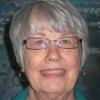It happens every first of June. The apple tree outside the library window at Green Mountain Monastery in Greensboro, Vt., bursts forth with blossoms.
The blooms have maintained their timely schedule for the past five years, beginning the day 94-year-old Fr. Thomas Berry died. Srs. Gail Worcelo and Bernadette Bostwick recently discussed the phenomenon in a blog on the monastery’s website.
Berry, a Passionist priest, cultural historian and initiator of the spiritual ecology movement, co-founded the monastery with Worcelo and Bostwick several years before his death in 2009. Green Mountain is dedicated to the bringing together of humans with Earth and its species in a mutually enhancing relationship, through retreats and workshops. The venerable geologian Berry is buried there on the grounds in a meadow, similar to the one he loved so much as a young boy in North Carolina.
In the blog, the two women recalled the morning of Berry’s passing. Filled with sadness, they looked out the library’s picture window and “noticed a tree bursting with apple blossoms. In that instant it was as if Thomas had made his presence known! We felt Thomas so alive and immediate and knew that he had simply shed the vessel of his body and was able now to be more expansive and without limitation.”
The sisters regard the blossoms as evidence of “his resurrection and freedom,” and that “Thomas is making his beautiful presence felt!”
At the same time Berry was waking up the flowers in Vermont, a group of folks down south in Chapel Hill, N.C., were celebrating his life and work at the Piedmont Bioregional Festival. Themed as “The Ecozoic Shift: An Earth for All Beings,” the festival was the culmination of a series of events beginning with a colloquium on his work held May 30-June 1.
Sponsored by the Center for Ecozoic Societies and nine other groups, the event celebrated Berry’s 100th birthday. Speakers, many of them students and mentees of Berry, who taught at numerous schools including Fordham University, presented papers on the importance and applications of his teachings. They examined some of the real transitions needed in our present world to heal the damage to the environment brought on by fossil fuel mining and corporate growth.
Among the speakers was Mike Bell, a former Passionist who studied with Berry as a seminarian. Since then, Bell has worked in the Canadian Arctic with indigenous Inuit and Dene cultures and is an organizer against fossil fuel projects in the Comox Valley on Vancouver Island.
At the festival Bell, who provided NCR a copy of his talk, spoke of the need to develop a functional cosmology “in the trenches.”
How do proponents of Berry’s Great Work -- healing the planet -- convince a culture fixated on profit and use, that our world is a communion of subjects, not a collection of objects, he asked.
Berry often spoke of story-telling and shared dream experiences as ways to change perceptions, said Bell, who told how his community uses those elements to push against the federal government of Canada under Prime Minister Stephen Harper and the provincial government in British Columbia under Premier Christy Clark.
“They are trying to turn our country into a super energy state by digging up tar sands, gas and coal and transporting them by pipelines and huge tanker ships for sale abroad,” Bell said.
He cautioned that community activist work is not about winning, “though it is nice when we do. It is about some spiritual power that rises up within you and makes you do things because it is the right thing to do.”
A project will not bring this spiritual power to you, he said. Instead, “It is something you bring to the project or develop when you get involved.”
To survive in the fight against the corporate culture, Bell explained, “you have to be spiritually grounded. For some it is daily practice of meditation or contemplation, for others it is a walk in the woods and communing with nature. For some it is prayer -- listening to creation for guidance -- but it is always some kind of spiritual practice that grounds us and enables us to continue in the long haul.”
Besides grounding in spiritual practice, activists need some type of community engagement, he said. The Comox Valley has numerous groups, most of them voluntary, providing a range of community services around the environment, labor unions, farms, food security and health care groups, all attempting to build a common ground.
Coming together collectively be a tough thing to accomplish, he acknowledged, but the starting point is building coalitions “around our love of this valley.”
“We don’t just complain about things,” Bell said. “We stress clean energy and green jobs, limits to carbon, better housing and support for small businesses, building upon issues that affect people directly and about which they have an emotional investment.”
Community groups have supported the First Nations, Canada’s native communities, and their efforts to stand up for their traditional rights, he said. Some churches have recently come on board by opposing coal projects.
Through these actions, Bell said, “we create and tell the new story and share a dream, reflect on our experiences and take care of ourselves and one another.”



